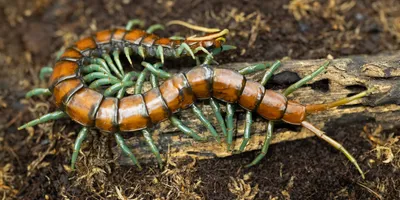Introduction to Centipede Venom
Often shrouded in an aura of fear and mystery, centipede venom, a complex biochemical cocktail produced by these ancient arthropods, is rapidly emerging as a valuable and underexploited resource in biomedical research. While their menacing appearance and venomous reputation have long overshadowed their scientific potential, centipedes harbor an arsenal of bioactive compounds with the capacity to revolutionize pain management and neuropharmacology. With global research interest on the ascent, the critical demand for high-quality centipede venom has become a significant limiting factor in this promising field. Stepping into this specialized yet crucial scientific niche is Centipede Venom Pharm (CVP), founded by Randy Mercurio in 2012. As one of the few dedicated suppliers, CVP caters to the exacting needs of researchers worldwide. Through meticulous species collection, advanced venom extraction methods, and unparalleled taxonomic expertise, CVP provides scientists with the essential tools for discovering novel drugs and meticulously studying neural processes. This article delves into the burgeoning scientific value of centipede venom, the inherent challenges of working with these myriapods, and the pivotal role CVP plays in enabling groundbreaking venom-based research.
Centipede Venom Compounds and Their Medical Potential: A Reservoir of Neurologically Active Compounds
Centipede venom is a veritable goldmine of proteins, peptides, and other organic molecules that exhibit highly specific interactions with the nervous system. These venoms have been honed by millennia of evolution to immobilize prey by precisely targeting ion channels and nerve receptors. This inherent specificity makes them an invaluable resource for unraveling the intricacies of neural pathways and developing innovative pain therapies. Researchers are particularly captivated by the mechanisms through which centipede venom components interact with gated ion channels. These microscopic gateways control the flow of ions across nerve cell membranes, and by modulating their activity, researchers can potentially alter pain signals, paving the way for the development of highly effective, non-opioid analgesics. As Randy Mercurio, founder of CVP, states, "Most of the research is directed toward discovering novel organic compounds, including proteins, that have very specific chemical interactions with the nervous systems of organisms."
Medicinal Applications of Centipede Venom
The diverse array of bioactive compounds found in centipede venom holds immense promise across several medical domains:
- Pain Management: Specific peptides identified in centipede venom have demonstrated significant potential in blocking sodium channels, which are intimately involved in the transmission of chronic pain signals.
- Neurological Disorders: Scientists are actively exploring how the venom's remarkable specificity can be harnessed to design targeted drugs for debilitating conditions such as epilepsy, multiple sclerosis, and other neurodegenerative diseases.
- Antimicrobial Agents: Emerging research is also shedding light on the surprising antimicrobial properties of certain venom-derived peptides, suggesting a potential role in combating resistant infections.
Solving the Supply Challenge of Centipede Venom
One of the foremost hurdles in advancing centipede venom research is the acute scarcity of high-quality venom. Each adult centipede produces only a minute amount of venom, necessitating the establishment and maintenance of large colonies to yield sufficient quantities for rigorous laboratory analysis. "In order to get more venom in a timely manner, you simply need more centipedes," notes Mercurio, underscoring the logistical complexity. "Which cycles back to caring for hundreds of centipedes on a regular basis."
Venom Extraction and Preservation Techniques
To overcome these inherent limitations, CVP employs a proprietary extraction method meticulously designed to ensure the safety of both the handler and the centipedes. The extracted venom then undergoes stringent preservation techniques to maintain its integrity and bioactivity:
- Sub-zero Freezing: Extracted venom is immediately subjected to sub-zero temperatures to stabilize its delicate biochemical components.
- Lyophilization (Freeze-drying): This crucial process removes water from the venom, allowing for long-term storage without any loss of its vital bioactivity. This meticulous approach enables CVP to consistently deliver reproducible, high-purity venom samples, which are indispensable for sensitive biochemical assays and the rigorous demands of pharmaceutical research.
Centipede Species Diversity and Global Sourcing
CVP maintains a diverse collection of approximately a dozen centipede species, carefully sourced from various biogeographical regions across the globe. This species diversity is critical, as the venom composition can vary significantly between different centipede species, offering researchers a broader spectrum of compounds to investigate.
Region | Notable Species |
|---|---|
North America | Lithobius forficatus (Rock Centipede) |
Africa | Large Scolopendra species |
Asia | Scolopendra subspinipes |
South America | Ethmostigmus species |
These species range in size from a mere 2 inches to over 10 inches and are often sourced from the pet trade industry, meticulously vetted for their suitability in scientific research.
Taxonomic and Biological Expertise in Centipede Venom
Randy Mercurio, a highly accomplished chilopodologist (an expert in centipedes), brings a profound depth of knowledge to CVP. His expertise encompasses:
- Taxonomy: The scientific classification of centipedes.
- Anatomy: The structural organization of centipedes.
- Biogeography: The geographical distribution of centipede species.
- Natural History: The ecological interactions and life cycles of centipedes. This extensive expertise empowers CVP to not only supply venom but also to serve as a invaluable resource for researchers, assisting them in species selection and even facilitating project-specific centipede cultivation. As Mercurio highlights, "Some researchers may be interested in knowing more about centipede taxonomy, anatomy, and biogeography... others may benefit from us raising specific species to facilitate a particular type of project."
Customized Research Support and Collaboration
Distinguishing itself from other venom suppliers, CVP actively fosters direct collaboration with researchers. This approach allows CVP to tailor its services precisely to the specific research needs of individual scientists and institutions. "I think there might be other facilities that offer centipede venoms, but I don’t think they have the same kind of knowledge we have... or the collaborative capabilities," Mercurio emphasizes, underscoring CVP's unique commitment to partnership.
Lab Management Certificate
The Lab Management certificate is more than training—it’s a professional advantage.
Gain critical skills and IACET-approved CEUs that make a measurable difference.
Operational and Logistical Insights in Centipede Venom Supply Day-to-Day Management of Centipede Colonies
Operating CVP is a demanding and multifaceted endeavor. It involves:
- The daily care of hundreds of centipedes, each requiring specific environmental conditions and feeding regimens.
- Mercurio's commitment to maintaining a full-time job outside of CVP, demonstrating his dedication to this critical scientific venture.
- The continuous challenge of sourcing new species from a limited marketplace.
- Ensuring a consistent and reliable venom yield through expert colony management and controlled breeding programs. Mercurio addresses these challenges with unwavering dedication and innovative solutions, including ongoing research into captive breeding to ensure species continuity and fostering collaborations to expand sourcing networks.
Digital Expansion and Access to Venom Resources
Looking ahead, CVP plans to launch a new e-commerce platform by the end of the year. This digital expansion will significantly streamline the ordering process for researchers and institutions globally, enhancing accessibility to their invaluable venom resources. "Meanwhile, we are always looking for ways to improve our business and continue to study all aspects of centipedes to expand our relatively poor knowledge of this incredible group of myriapods," Mercurio shares, highlighting CVP's commitment to continuous improvement and scientific advancement.
Future Outlook for Centipede Venom in Medical Research
The exploration of centipede venom as a medicinal resource is still in its nascent stages but holds immense promise for revolutionary breakthroughs. Thanks to the pioneering efforts of Centipede Venom Pharm and the expertise of visionaries like Randy Mercurio, researchers now have unprecedented access to the venoms and biological insights required to drive forward critical neurological and pharmaceutical discoveries. As interest in this fascinating natural resource continues to grow and scientific technology evolves, centipede venom may soon be recognized not merely as a potent natural toxin, but as a foundational cornerstone of next-generation medicine.
Frequently Asked Questions (FAQ)
Q1: What medical applications does centipede venom have? Centipede venom holds significant potential in pain management, neurological disorders like epilepsy and multiple sclerosis, and also exhibits promising antimicrobial properties against resistant infections. Its compounds interact specifically with the nervous system, offering pathways for novel drug discovery.
Q2: Why is obtaining centipede venom for research challenging? High-quality centipede venom is scarce because each centipede produces only a tiny amount, requiring large colonies for sufficient quantities. Specialized suppliers like Centipede Venom Pharm (CVP) overcome this by meticulously caring for hundreds of centipedes and employing advanced extraction and preservation techniques like lyophilization.
Q3: What role does Centipede Venom Pharm (CVP) play in this research field? CVP is a leading specialized supplier providing researchers with high-quality centipede venom. Founded by chilopodologist Randy Mercurio, CVP offers deep expertise in centipede taxonomy and biology, custom research support, and ensures a consistent supply of venom through careful colony management and sourcing.
Q4: Are new drugs derived from centipede venom expected soon? Research into centipede venom for drug discovery is still in early stages but shows immense promise. Scientists are actively identifying novel compounds with specific interactions in the nervous system, aiming to develop next-generation pain relievers and treatments for various diseases. The field is a promising frontier for future pharmaceutical breakthroughs.











